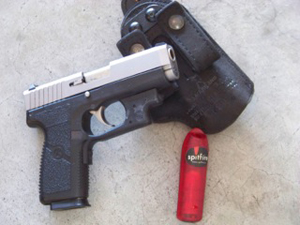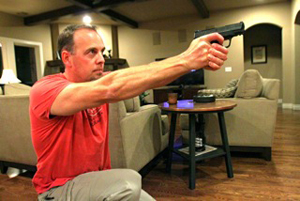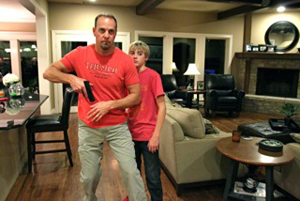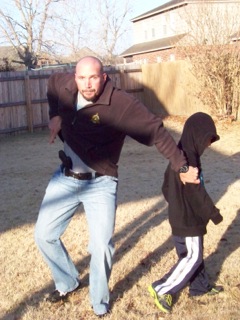
Having multiple defensive options is always a smart move, but some situations require a firearm. Get one, train with it, and be prepared to use it in dynamic situations.
I write this in the wake of numerous active-shooter incidents, including the Colorado movie theater shooting that killed 12 and injured 58, and the Sandy Hook Elementary School shooting in Connecticut that killed 27. It sickens me to think of such things, and saddens me that the loss of life could have been prevented by one well-trained armed individual who was not among the crowd.
Many of you who read this have already taken the responsibility of arming yourself for self-defense purposes. Most of you probably train routinely. Most of you know how to shoot pretty well, and have likely refined your techniques to the point where you could use them if necessary. The question is, how many of you have practiced with the family members you may be defending? How many of you have addressed the other side of the coin, such as what you expect your significant other to do during an attack? Do your kids know you are regularly armed and if so, have you ever taught them their roles in a life-or-death situation where gunfire may occur? If you have no answers to these questions, then this article will hopefully guide you to setting yourself and your family (or friends) up for success if the nightmare like the one in Colorado ever occurs where you are.


If you find yourself in a crowd where shooting innocents is possible, consider using angles to mitigate that shoot-through possibility.
Get Legal, Get Trained, and Go Armed
I am still surprised by the incredible number of people who just do not carry a gun. Simply Google “shootings” and you will find the most recent criminal assault in a mall, parking lot, movie theater, church, etc. It happens everywhere, folks, and it can happen to you. Stop thinking that because you live in a nice area and frequent nice places that bad things can’t happen. I also encourage people to train with and have other self-defense options such as chemical sprays and tasers available to them, but the bottom line is that when the situation calls for a gun solution, then a gun is needed. Get one and carry it all the time.
Communicate Your Intentions
Children over a certain age (my seven-year-old knows I carry) need to know you are armed and what you may do if confronted with a lethal threat. Your wife, husband, boyfriend, girlfriend, good buddy, and anyone else you might be around need to be informed you are armed, and what they need to do during the situation. Obviously I don’t recommend you tell everyone you are with at all times that you have a gun, but the people you hang with the most need to know their role if something bad happens.
Have a Plan for a Bad Situation
A sound tactical plan should consist of multiple components, including communication (verbal and non-verbal), pre-incident actions, during-incident actions, and post-incident actions. Here is what I have rehearsed with my loved ones.
Communication
I have a pre-attack verbal cue that my wife and I both know and that will elicit a response. For example, if I become aware of an impending threat, I visually lock on the threat (my wife recognizes this) and communicate, “Take cover.” We don’t use that verbiage in normal communication, and it is clear and concise. Our non-verbal communication consists of visual scanning to make eye contact with her after the incident. She knows that she must attempt to position herself so I can see her after the event, and that her or my ability to hear may be limited.

If you are the primary defender, your family member (wife, husband, etc) needs to know their role also. Here the secondary defender moves the children to a safer area while the primary defender handles the situation. This must be practiced (dry fire or with a red gun) with all members of the family in order for it to work under stress!
Pre-Incident Actions
My pre-incident actions occur if the threat/situation is recognized in advance. They include physical or verbal communication to my family members, and positioning to avoid the attack or place obstacles between us. My wife and I have a specific verbal command that if used will prompt both of us to go into immediate action. I suggest you have some sort of communication plan with your family so there will be no mistaking the command or what it means. In addition, my wife’s pre-incident actions may include positioning herself closer to cover, physically taking control of our children, and/or visually scanning for somewhere safe to run to if things go bad. In a spontaneous attack, there may be no pre-incident actions because the situation unfolds quickly.
During-Incident Actions
Your role is that of primary defender. That means shoot, strike, or use intermediate weapons as necessary to deter the threat. If you are with your family and your spouse is armed, one of you needs to take the role of primary defender. Whoever will have the most success dealing with a larger and stronger opponent should assume that role. The other’s role is to control and move the kids (if they are there), as well as him/herself offline of the attack and to a safe position. Your spouse should understand that standing close to you while you are being shot at is not good because of the incoming fire.

Move in front of a stunned child if offline movement is not an option. Consider that your family members may freeze or may not know the attack is occurring, therefore you have to train to get between them and the threat. Obviously, getting them offline is the best option.
If I am attacked while with my kids and/or wife, I will likely aggress the threat and go into more of an attack mode because I do not want to move offline with them and draw fire toward them. That said, I would still use obstacles and cover to my advantage if feasible. I can remember years ago while in the Marine Corps, I was introduced to the tactic of assaulting an ambush and I thought the concept was crazy. But the truth is that assaulting the ambush is often the best course of action. Consider this tactic if ambushed by an active shooter while with your family.
Post-Incident Actions
After the incident has ended and everyone is hopefully safe, your priorities are to get the communication going again and assess for injuries to loved ones. I believe in a post-engagement scanning process that forces you to visually look around you after the incident. During this scan, try to make eye contact with family members. If the threat is down and the immediate area clear, consider communicating outside your group to other people in the area, as well as to the authorities through 911. If you are with family, your significant other may have the role of calling 911 and communicating with authorities. Your job is still the primary defender, so you may have to maintain a defensive posture toward the downed shooter, or be aware of others.
Having a plan and rehearsing it are critical to your success if you are unfortunate enough to be in an active-shooter situation. In addition to having a plan, use good defensive strategies to increase your chances of survival, such as positioning yourself in public places where you always have two directions of exit. Consider where possible attackers may come from and position yourself and family members so you can get out of the area as quickly as possible.
Can One Armed Good Guy Make a Difference?
Dozens of people, including family members, have asked me how an armed person should have responded in Colorado, and if they would have made a difference. While I can’t answer whether or not an armed and well-trained person could have made a difference, I want to say I wish they would have had a chance. What I do know is that dozens of unarmed individuals faced one armed man and had little chance of success because of that disparity of force. If you were armed in that theater, you would have indeed been in one of the worst situations imaginable. My personal choice is to have the tools and skill with those tools to at least attempt to make a difference, rather than be defenseless for the slaughter.

Practice accessing a gun while using the off hand to clear a person dry fire and with simple range props like this target stand. The main goal is to put moving offline and clearing the person offline together in the draw process.
How do we train for a situation like that? Stick to the fundamentals and train them until you have a high level of skill. Include the skills needed for different situations, including low light. Learn to apply tactics to increase your survivability, and visualize succeeding in a chaotic situation like that. Convince yourself to think, make decisions, and handle one thing at a time. If you have spent the time training your skills, they will be there when you need them. There is probably no single drill that can simulate such a chaotic situation, so don’t look for one.
Useful Training Drills
Stick to basic yet correct training drills that will build your skills up to a high level across the board. Some useful techniques you should learn and train are:
* Drawing while moving around someone to gain a good field of fire and prevent them from getting in front of the muzzle.
* Shooting on the move toward someone (assaulting the ambush).
* Effective head shots, and finding out what your limitations are. How far away can you hit the head when not under stress?
* Angled shots, both up and down. High angled shots from a seated or kneeling position will travel up and out of a crowd if the bullet misses. Low angled shots fired from a standing or high position into the pelvic/groin areas may travel low and into the ground rather than the crowd.

With a young family member, I strongly recommend practicing this dry fire or with a S.I.R.T. or red gun. There is no benefit to using a live firearm with someone so young. Practice smart!
Please join me in honoring those fallen in Connecticut, Colorado and other locations in recent times. Train like your life depends on it – because it does!

This was a good article. Training with the family makes lots of sense and is often overlooked or under practiced.
I wish there where most places in the state of WA. to get proper training. I can't get my wife to understand the importance of it. I can't even get her to shoot her own pistol?
great article. i have gone over most of this stuff and while a pelvic shot or down ward angled shot is fine if there is dirt under you, but most of this happens in places that would have a concrete floor. having learned this is not billards the ricochet angle will be close to the floor. which would put people behind if there were any in danger. always know your backstop and what your bullet will do in different backstops. in that situation dropping to the floor would put your self in danger if his round hit in front of you. boy, this stuff gets complicated. hope none of us ever has to play for real.
Also I am a member of PDN (Personal Defense Network). Can I download this article?
Great article Mike. By the way, I prefer articles over videos because I have slow internet here in my overseas location.
I had a problem in a Walmart Parking lot with my wife in harms way. My first response was to get her the h*ll out of the way telling her clearly what to do in Russian.... and then engage the threat. As my wife is Russian, we do not speak in English when I engage a threat. Turns out that the 'threat' was an off duty PD dealing with a robbery suspect. Was I ever so glad I did not engage but decided to call 911. My family was ok, I was in a position of tactical advantage and did not know "...all the players...". Just because I have a custom built Smith 36, does not mean that I need to use it unless I have no choice. (yea, I carry a wheel gun because you point it....pull the trigger...it goes BANG. Further, it don't leave a mess all over the floor. Never did like 'bottom feeders'.) Giggles and Grins.......
Great article.
A lot of my time is spent in church, around crowds. One of the tactics that I might use when bad guys are very close, would be to fall to my knees, rip the bottons off of my shirt and loudly say, "oh no my heart!" While doubled over and my hands are out of sight, I would draw my weapon and fire upwards into the bad guy. My wife is aware of this tactic and would not come running to help me.
An excellent article. I have thought about these situations and scenarios and have considered many of the ideas and shooting positions talked about here.The last thing anyone needs is casualties by friendly fire. Practice both mentally and physically and pray we are never in a situation.
I've been practicing with bb pistols and airsoft, but this article makes me think more about family situations. Thank you. Great article and I'd rather have it and not need it than need it and not have it!